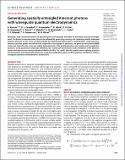Generating spatially entangled itinerant photons with waveguide quantum electrodynamics
Author(s)
Kannan, B; Campbell, DL; Vasconcelos, F; Winik, R; Kim, DK; Kjaergaard, M; Krantz, P; Melville, A; Niedzielski, BM; Yoder, JL; Orlando, TP; Gustavsson, S; Oliver, WD; ... Show more Show less
DownloadPublished version (635.9Kb)
Publisher with Creative Commons License
Publisher with Creative Commons License
Creative Commons Attribution
Terms of use
Metadata
Show full item recordAbstract
© 2020 The Authors, some rights reserved; exclusive licensee American Association for the Advancement of Science. No claim to original U.S. Government Works. Distributed under a Creative Commons Attribution NonCommercial License 4.0 (CC BY-NC). Realizing a fully connected network of quantum processors requires the ability to distribute quantum entanglement. For distant processing nodes, this can be achieved by generating, routing, and capturing spatially entangled itinerant photons. In this work, we demonstrate the deterministic generation of such photons using superconducting transmon qubits that are directly coupled to a waveguide. In particular, we generate two-photon N00N states and show that the state and spatial entanglement of the emitted photons are tunable via the qubit frequencies. Using quadrature amplitude detection, we reconstruct the moments and correlations of the photonic modes and demonstrate state preparation fidelities of 84%. Our results provide a path toward realizing quantum communication and teleportation protocols using itinerant photons generated by quantum interference within a waveguide quantum electrodynamics architecture.
Date issued
2020Department
Massachusetts Institute of Technology. Research Laboratory of Electronics; Massachusetts Institute of Technology. Department of Electrical Engineering and Computer Science; Lincoln Laboratory; Massachusetts Institute of Technology. Department of PhysicsJournal
Science Advances
Publisher
American Association for the Advancement of Science (AAAS)